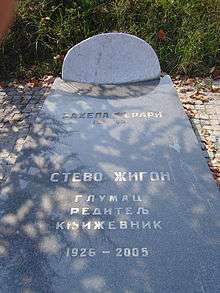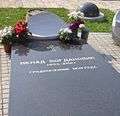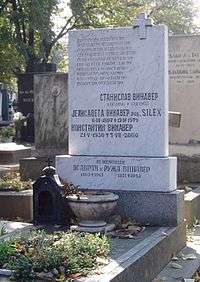Belgrade New Cemetery
|
Church of St. Nicholas at the cemetery | |
| Details | |
|---|---|
| Established | 16 August 1886[1] |
| Location | Zvezdara, Belgrade |
| Country | Serbia |
| Coordinates | 44°48′34″N 20°29′14″E / 44.80944°N 20.48722°ECoordinates: 44°48′34″N 20°29′14″E / 44.80944°N 20.48722°E |
| Type | Christian |
| Owned by | City of Belgrade |
| Size | 30 ha (74 acres)[1] |
| Website | Guide through the New Cemetery |
The New Cemetery (Serbian: Ново гробље, Novo groblje) is a cemetery complex in Belgrade, Serbia. It is located in Ruzveltova street in Zvezdara municipality. The cemetery was built in 1886 as the third Christian cemetery in Belgrade.
Except for the graves of ordinary citizens, the cemetery complex also includes special parts: military graves from Serbian-Ottoman War (1876-1877), Serbo-Bulgarian War, Balkan Wars and World Wars, the Alley of the Greats and Alley of Distinguished Citizens, where some of the most important persons of Serbian history are buried.
Location
The cemetery is located along the Ruzveltova (official seat, at No. 50) and Mije Kovačevića streets, which divide it in two sections, left or western, which is in the municipality of Palilula and right or eastern, which is in the municipality of Zvezdara. Larger, eastern section is bordered by the streets of Mije Kovačevića on the north, Severni bulevar on the east and Svetog Nikole on the south. North of this section are the neighborhoods of Bogoslovija and Stara Karaburma, Zvezdara II is on the east, while Slavujev Venac and Bulbulder are on the south. Smaller, western section is marked by the streets Čarlija Čaplina (northeast) and Preradovićeva (southwest). It is situated next to the neighborhood of Hadžipopovac.[2][3]
History
Vladanovac
As the city expanded, Belgrade’s old cemetery at Tašmajdan became inadequate. One the one side, it became too small for the function of the city’s main graveyard. On the other, once projected to be on the outskirts of the city, as Belgrade grew, Tašmajdan practically became downtown and close to the Royal court. As the city was in the financial crisis at the time and wasn’t able to buy such a large lot for the new cemetery, mayor of Belgrade Vladan Đorđević donated a patch of his land to the city for the purpose of establishing a new cemetery. In the next decades, the area, including the graveyard itself was known as the Vladanovac, after the mayor, but gradually was replaced with the name New Cemetery.[4][5] Mayors Živko Karabiberović and Mijailo Bogićević also worked on the establishment of the cemetery. Citizens originally disapproved the new location, as it was distant from downtown, so a horse-operated tram line was established, Terazije-New Cemetery. The adaptation of the lot was finished on 16 August 1886 and tomorrow the first person was buried in the new cemetery, Dragutin Dimić, son of the cemetery gardener Veljko Dimić. The graveyard originally covered 2 ha (4.9 acres), but by 2017 grew to 30 ha (74 acres).[1]
Period prior to 1945
New cemetery was charted into the city plans in 1884. First burials were held in 1886, but reinterment of the remains from the Tašmajdan dragged on in the several decades, being finished only in 1927.
Church of Saint Nicholas
The newly developed cemetery had no chapel or church, so by the endowment of Draginja and Stanojlo Petrović, a church dedicated to Saint Nicholas, projected by the architect Svetozar Ivačković was built in 1893. The iconostasis was painted by Stevan Todorović and the frescoes are work of Andrea Domenico, on the draft by Petar Ranosović. For a long time, the church also served for the parochial services, until the Church of Saint Lazar was built in the neighborhood of Bulbulder. In that period weddings and baptisms were also performed in the church, while the public fairs were held in front of it. First memorial monument was built in 1907, when remains of the Serbian soldiers who died in wars against the Turks and Bulgarians in the 19th century were reinterred from the Tašmajdan. During the bombardment of Belgrade in the World War I, cemetery was damaged in 1915. In 1931 Valery Vladimirovich Stashevsky projected Iverskaya chapel, a replica of the original chapel which existed in the Moscow Kremlin which the Bolsheviks demolished that same year (it was rebuilt in 1994-95). In the Interbellum, seven military graveyards were also formed so as The Monument and Memorial Ossuary to the Defenders of Belgrade 1914-1918.[4][1]
Period after 1945
Cemetery of Belgrade Liberators, for the soldiers who died in 1944, extension across the Ruzveltova street to the west, was built in 1954. In 1959, a memorial cemetery for all the fallen fighters of the World War II was built by the architects Bogdan Bogdanović and Svetislav Ličina. Ličina also projected the Alley of Distinguished Citizens in 1965. By the 1983 decision of the National Assembly of Serbia, the New Cemetery was declared as the cultural monument of great importance.[1][4]
Today
The first burials on the cemeteries that still exist today in the Belgrade's territory, were held in Zemun, at the end of the 18th century. However, the New Cemetery was the first which has been planned and projected specifically for this purpose, with all the infrastructure needed, so it is today considered to be the oldest of Belgrade's cemeteries. In 1886-2017 period, 340,000 people were buried.[1][4]
Among the headstones, there are 1,597 which are works of art by 130 Serbian sculptors, thus the cemetery is considered as the "museum in the open". Artists who contributed to this "museum" with their works include Ivan Meštrović, Đorđe Jovanović, Toma Rosandić, Sreten Stojanović, Petar Palavičini, Nebojša Mitrić, Risto Stijović, Živojin Lukić, Simeon Roksandić, Roman Verkhovskoy, Olga Jevrić, Giovanni Bertotto, Oto Logo, Petar Ubavkić, Lojze Dolinar, Stevan Bodnarov, Oscar Barbella and Nikola Janković.[1][4]
The complex
The entire complex consists of a group of military graveyards, and a Jewish cemetery, on the left side of the Ruzveltova, while part on the right side of the street consists of three architectural and memorial sections: Arcades, Alley of the Greats and Alley of Distinguished Citizens.[1]
Western portion
Military graveyards
The oldest memorial at Novo groblje complex is the Serbian soldiers' ossuary built in 1907 which contains remains of the soldiers of Serbian-Ottoman War and Serbo-Bulgarian War that were transferred from Tašmajdan cemetery.[6] Another important part of the complex are the military graveyards with the remains of soldiers from Balkan Wars and World Wars. It contains remains of Serbian and other Allied soldiers, as well as Axis soldiers (there are French,[6][7] Russian (including White émigrés after the October Revolution,[1][7] British (Commonwealth, from World War II),[1][8][9] Italian,[6] German, Austro-Hungarian[7] and Bulgarian[7] military graveyards).[10] The complex of military graveyards also includes graves of those died in the 1941 and 1944 Bombing of Belgrade.
Cemetery of Belgrade Liberators
Part of the Novo groblje complex, but on the other side of the street from the main part is the Cemetery of Belgrade Liberators (Гробље ослободилаца Београда / Groblje oslobodilaca Beograda).[10] It contains graves of 2,944 National Liberation Army soldiers and 961 Red Army soldiers and the mass grave of 1,381 National Liberation Army soldiers and 711 Red Army soldiers who died during the Belgrade Offensive.
The cemetery includes Liberators of Belgrade memorial with the relief by sculptor Rade Stanković and the Red Army soldier sculpture by Antun Augustinčić. In front of the memorial is the sculpture of a Partisan holding a gun by Rade Stanković.
Jewish cemetery
Next to the Cemetery of Liberators is the Jewish Sephardic cemetery with the remains of Jewish soldiers who died in the Balkan Wars and World War I, ossuary of Jewish refugees from Austria and the Memorial to the Holocaust victims and Jewish soldiers died in World War II by the architect Bogdan Bogdanović.[6]
The original Sephardic cemetery was established in 1888, further down the Dalmatinska Street. In 1925 it was moved across the New Cemetery, on the lot owned by Đorđe Kurtović, a merchant from Šabac, who sold it to the Jewish community. Today it covers 12,748 m2 (137,220 sq ft) and has over 4,000 tombstones.[11]
The cemetery is divided by the central pathway with an avenue of pines. Close to the entrance is the impressive Monument to dead soldiers from the 1912-1919 wars. It has inscribed 132 names of the Serbian Jewish soldiers. The monument combines Serbian (two headed eagle, fire-steels, lyrics by Njegoš), Jewish (Star of David) and military symbols (riffle, sabre, šajkača). In Jewish tradition, the pebbles have been placed next to the soldier's names.[11]
The stone-made Holocaust memorial which commemorates Jewish victims from 1941 to 1945 is at the end of the path. The access paths to the memorial are made from the remains of the Jewish houses demolished during the bombings of Belgrade and occupation in World War II. Though the monument is not that old, its exact symbolism is unknown. There are three explanations: 1) two wings represent the Ashkenazi and the Sephardic Jews while the space between with the menorah symbolizes the parting of the Red Sea by Moses and road to freedom; 2) tablets with 10 commands; 3) hands on one wing represent the Kohen while the pitcher on another represents the Tribe of Levi. Within the memorial are the ossuary with 197 skeletons and the urn with the remains of Bogdanović, upon his wish even though he was not Jewish, which was approved by the Serbian Jewish community.[11]
There is also a monument to the ill-fated 1939-41 Kladovo transport. It was erected in 1959 on a design by Andrija Mešulam, after 800 bodies of the victims were collected and reinterred here. Other notable feature is the tomb of the Buli family (Bencion Buli, banker and politician; Hugo Buli, who brought football to Serbia. He is not buried in the tomb as he was killed in a gas van and thrown out of it on an unknown location). A Holocaust victim, Avram S. Lević (1869-1941), who saved and protected the Miroslav Gospel in World War I, is also buried here. There is also a genizah, a "grave for the books", built in 1928. It is ornamented with an open scroll of Torah and books made of stone.[11]
Across this cemetery, there is a smaller Ashekazi cemetery, adjacent to the New Cemetery itself. It is known for its sculptures, including the "Kiss of death" by Toma Rosandić, on the tomb of Jakov and Ruža Klopfer. The Ashkenazi cemetery, founded in 1876, is closed for further expansion as there is no room left.[11]
Eastern portion
Arcades
Though this section is today next to the wall, it was originally envisioned as a series of arches ("arcades"). It contains tombs of important public figures and wealthier citizens. Here are the graves of Nikola Pašić (1844-1926), politician, Milenko Vesnić, politician and diplomat, Janko Vukotić (1866-1927), general and politician, Sreten Stojanović (1898-1960), sculptor, Svetlana Velmar-Janković (1933-2014), writer.[1]
Alley of the Greats
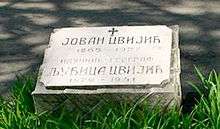
Alley of the Greats (Serbian: Алеја великана / Aleja velikana) was created in the 19th century with move of the greats from the Tašmajdan Cemetery to the New Cemetery. As an architectural unit, it was formed in 1926-27 as the first lot specifically designed for the nationally important people. It contains 25 tombs and 3 chapels with 113 buried people by 2017.[1] Some of the people buried at the Alley of the Greats are:
- Jovan Cvijić (1865–1927), geographer[12]
- Svetozar Gligorić (1923-2012), chess player[13]
- Kosta Hristić (1852–1927), diplomat and writer[14]
- Stevan Hristić (1885–1958), composer[15]
- Slobodan Jovanović (1869–1958), philosopher and politician[16]
- Petar Kočić (1877–1916), writer[17]
- Ilija Milosavljević Kolarac (1789–1878), donator[18]
- Živojin Mišić (1855-1921), fieldmarshal[1]
- Branislav Nušić (1864-1938), comedy playwright[1]
- Kornelije Stanković (1831–1865), composer[19]
- Radomir Putnik (1847-1917), fieldmarshal[1]
- Dimitrije Tucović (1881-1914), socialist leader[1]
- Miloš Vasić (1859-1935), general and weapons constructor[1]
Alley of Distinguished Citizens
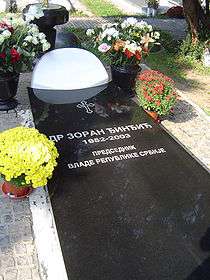
Alley of Distinguished Citizens (Serbian: Алеја заслужних грађана / Aleja zaslužnih građana) was formed in 1965,[6] and that alley is used since then for the distinguished and important citizens burial, after special procedure and approval of the City Assembly of Belgrade and Mayor of Belgrade. It contains single and group tombs of important writers, artists, actors, generals, people's heroes and other important persons. It occupied the central part of the cemetery and by 2017 there were 716 people buried in this section.[1] Some of the people buried at the Alley of Distinguished Citizens are:[20]
- Paja Jovanović (1859–1957), painter. The urn with his ashes was transferred here after his wife's death.[21]
- Slobodan Jovanović (1869–1958), historian, lawyer, literary critic and politician[6]
- Milo Milunović (1897–1967), painter[6]
- Radivoj Korać (1938–1969), basketball player[22]
- Bojan Stupica (1910–1970), theater and film director[23]
- Petar Lubarda (1907–1974), painter[24][6]
- Ivo Andrić (1892–1975), writer and Nobel Prize winner[25]
- Miloš Crnjanski (1893–1977), poet, author, and a diplomat[26]
- Ivan Tabaković (1898–1977), painter[6]
- Ljubinka Bobić (1897–1978), actress[27]
- Stojan Aralica (1883–1980), painter[28]
- Meša Selimović (1910–1982), writer[6]
- Dušan Radović (1922–1984), journalist and writer[29]
- Branko Ćopić (1915–1984), writer[6]
- Zoran Radmilović (1933–1985), actor[30]
- Matija Vuković (1925–1985), sculptor[28]
- Kosta Nađ (1911–1986), Yugoslav Partisan Army general[6]
- Danilo Kiš (1935–1989), writer[31]
- Oskar Davičo (1909—1989), writer[6]
- Stjepan Bobek (1923–2010), footballer
- Rrahman Morina (1943–1990), communist politician[28]
- Miodrag Bulatović (1930–1991), writer[6]
- Vasko Popa (1922–1991), poet[6]
- Borislav Pekić (1930–1992), writer[6]
- Koča Popović (1908–1992), Partisan Army general, Chiefs of the General Staff of the Yugoslav People's Army, Foreign Minister, Vice President of Yugoslavia[28]
- Rahela Ferari (1911–1994), actress[6]
- Mija Aleksić, (1923–1995), actor[32]
- Milić od Mačve (1934–2000), painter[6]
- Radmila Savićević (1926-2001), actress[6]
- Zoran Đinđić (1952–2003), Prime Minister of Serbia[33]
- Bata Paskaljević (1923–2004), actor[6]
- Stevo Žigon (1926–2005), actor and director[6]
- Ljuba Tadić (1929–2005), actor[34]
- Žika Mitrović (1921–2005), movie director and screenwriter[6]
- Dragan Lukić (1928-2006), poet[6]
- Nenad Bogdanović (1954–2007), Mayor of Belgrade[35]
- Mira Alečković (1924–2008), poet[6]
- Olja Ivanjicki (1931–2009), painter and sculptor[6]
- Mladen Srbinović (1925—2009), painter[6]
- Milorad Pavić (1929–2009), writer and literary historian[6]
- Oskar Danon (1913–2009), composer and conductor[6]
- Rade Marković (1921–2010), actor[6]
- Momo Kapor (1937–2010), writer and painter[6]
- Voki Kostić (1931–2010), composer[6]
- Petar Kralj (1941–2011), actor[6]
- Branislav Crnčević (1933–2011), writer and politician[6]
- Olivera Marković (1925–2011), actress[6]
- Milorad Bata Mihailović (1923–2011), painter[6]
- Jelena Genčić (1936–2013), tennis and handball player and coach[28]
- Ružica Sokić (1934–2013), actress[28]
- Nebojša Glogovac (1969–2018), actor[36]
Gallery
References
- 1 2 3 4 5 6 7 8 9 10 11 12 13 14 15 16 17 18 Branka Vasiljević (30 September 2017), "Muzej pod otvorenim nebom", Politika (in Serbian), p. 15
- ↑ Beograd - plan i vodič. Geokarta. 1999. ISBN 86-459-0006-8.
- ↑ Beograd - plan grada. M@gic M@p. 2006. ISBN 86-83501-53-1.
- 1 2 3 4 5 Dimitrije Bukvić (28 October 2012), "Obnova najstarijeg groblja u prestonici", Politika (in Serbian)
- ↑ Dragan Perić (23 April 2017), "Šetnja pijacama i parkovima", Politika-Magazin No 1021 (in Serbian), pp. 28–29
- 1 2 3 4 5 6 7 8 9 10 11 12 13 14 15 16 17 18 19 20 21 22 23 24 25 26 27 28 29 30 31 32 33 34 35 NEW CEMETERY Archived July 7, 2009, at the Wayback Machine., Turistički vodič kroz Beograd
- 1 2 3 4 "Archived copy". Archived from the original on 2010-04-13. Retrieved 2009-10-25.
- ↑ "Casualty details—Clinton, Walter". Commonwealth War Graves Commission. Retrieved 1 November 2009.
- ↑ "Casualty details—Jovanovic, Ratko G." Commonwealth War Graves Commission. Retrieved 1 November 2009.
- 1 2 VOJNIČKA GROBLJA > Oltari sebičnih otadžbina, Vreme, 22 April 2004 (retrieved: 22 October 2009) (in Serbian)
- 1 2 3 4 5 Branka Vasiljević (3 June 2018). "Spomenik istorije i kulture pod otvorenim nebom" [Cultural monument in open air]. Politika (in Serbian).
- ↑ Novo groblje official site: Jovan Cvijić
- ↑ "Sahranjen legendarni šahista Svetozar Gligorić". Blic Sport. 17 August 2012. Retrieved 14 February 2018.
- ↑ Novo groblje official site: Kosta Hristić
- ↑ Novo groblje official site: Stevan Hristić
- ↑ "Slobodan Jovanović konačno počiva u Srbiji". www.novosti.rs.
- ↑ Novo groblje official site: Petar Kočić
- ↑ Novo groblje official site: Ilija Kolarac Milosavljević
- ↑ Novo groblje official site: Kornelije Stanković
- ↑ List of notable people buried at New Cemetery, Official cemetery website Archived October 18, 2009, at the Wayback Machine.
- ↑ "Pavle Paja Jovanović". Official website of Novo Groblje. Archived from the original on 2010-04-13. Retrieved 2018-02-14.
- ↑ "Radivoje Korać". Official website of Novo Groblje. Archived from the original on 2010-04-13. Retrieved 2018-02-14.
- ↑ "Bojan Stupica". Official website of Novo Groblje. Archived from the original on 2010-04-13. Retrieved 2018-02-14.
- ↑ "Petar Lubarda". Official website of Novo Groblje. Archived from the original on 2010-04-13. Retrieved 2018-02-14.
- ↑ "Ivo Andrić". Official website of Novo Groblje. Archived from the original on 2009-10-19. Retrieved 2009-10-24.
- ↑ "Želeli su i u smrti - zajedno". Večernje novosti. 29 December 2007. Retrieved 14 February 2018.
- ↑ "Ljubinka Bobić". Official website of Novo Groblje. Archived from the original on 2009-10-20. Retrieved 2018-02-14.
- 1 2 3 4 5 6 "SRAMOTA Po šest velikana u jednom grobu". Blic. 13 May 2014. Retrieved 14 February 2018.
- ↑ "Dušan Radović". Official website of Novo Groblje. Archived from the original on 2010-04-13. Retrieved 2018-02-14.
- ↑ "Zoran Radmilović". Official website of Novo Groblje. Archived from the original on 2010-04-13. Retrieved 2018-02-14.
- ↑ "Danilo Kiš". Official website of Novo Groblje. Archived from the original on 2009-10-19. Retrieved 2018-02-14.
- ↑ "Milosav Mija Aleksić". Official website of Novo Groblje. Archived from the original on 2009-10-19. Retrieved 2018-02-14.
- ↑ "Zoran Đinđić". Official website of Novo Groblje. Archived from the original on 2009-10-19. Retrieved 2009-10-24.
- ↑ "Ljubivoje Ljuba Tadić". Official website of Novo Groblje. Archived from the original on 2010-04-13. Retrieved 2018-02-14.
- ↑ "Sahranjen Nenad Bogdanović". Politika. 1 October 2010. Retrieved 14 February 2018.
- ↑ "SAHRANJEN NEBOJŠA GLOGOVAC Hiljade ispratile velikog glumca na večni počinak, među njima veliki broj javnih ličnosti". Blic. 12 February 2018. Retrieved 14 February 2018.
External links
| Wikimedia Commons has media related to Novo groblje Beograd. |
- Novo groblje
- Novo groblje sa Alejom velikana at [www.ANTIC.org] (in Serbian)
- Nenad Bogdanović will not sign decision about Slobodan Milošević burial in the Alley of Distinguished Citizens, 13. Mart 2006. (in Serbian)
- Ljuba Tadić buried in the Alley of Distinguished Citizens (in Serbian)
- Mayor of Belgrade Nenad Bogdanović buried in the New Cemetery, 30. September 2007. (in Serbian)
- CWGC: Belgrade new cemetery
- Novo groblje u Beogradu, RTS, 4 September 2009

